Article
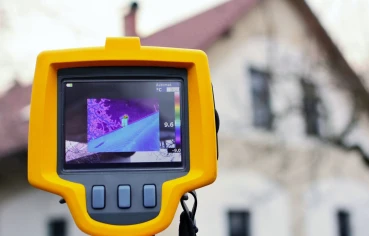
Kamera Pencitraan Termal untuk Inspeksi Bangunan dan Rumah
Thermal Imaging
Jika kebocoran panas melalui sistem HVAC tidak terdeteksi dan ditangani, konsumsi energi akan makin boros. Biaya yang ditanggung oleh pemilik rumah dan bisnis pun makin membengkak. Beberapa tahun lalu, Chip Wade, kontraktor profesional menjelaskan satu kiat kepada kami. Ia mengatakan bahwa memeriksa sistem HVAC dengan teknologi pencitraan termal merupakan cara terbaik dan tercepat untuk menunjukkan sumber kebocoran energi HVAC kepada pemilik rumah dan bisnis.
Ada beberapa hal tidak pernah berubah.
Sejak dipublikasikannya video dari Chip, inovasi dalam teknologi pencitraan termal kini mampu menghasilkan citra dan video yang lebih detail. Dalam beberapa kasus pun, inovasi tersebut mampu mendeteksi imbas masalahnya.
Tonton video Chip yang mengajak kita menjelajahi rumah berusia 100 tahun untuk memahami penggunaan pencitraan termal guna mengidentifikasi kebocoran panas secara cepat dan efisien melalui sistem HVAC.
Transkrip:
“Saat melakukan pemeriksaan rumah yang akan dijual atau direnovasi, efisiensi energi adalah salah satu hal yang perlu Anda pertimbangkan. Sudah barang tentu, inilah yang berkutat di benak sang pembayar tagihan energi.
Fluke TiR1 thermal imager adalah alat terbaik untuk memeriksa kebocoran panas di saluran pipa, dinding, dan sekitar ventilasi. Seperti yang kita duga, ada beberapa area di rumah berusia ratusan tahun ini yang perlu diperbaiki.
Pertama, ventilasi. Idealnya, saat menutup ventilasi, Anda tidak ingin ada udara panas keluar dari situ. Coba lihat ventilasi tertutup ini melalui Fluke TiR1. Ventilasi tua ini tidak tertutup rapat sehingga ada kebocoran energi.
Sekarang kita berada di kamar mandi lantai atas. Di sini ada masalah yang sudah menyebar di saluran pipa rumah ini. Jika Anda melihat ventilasi tertutup ini melalui pencitra, tampak panas keluar dari keempat sisinya. Jika melihat di sebelah kanan, panas akan keluar dari atas dan bawah baseboard. Artinya, ada kerusakan sambungan pipa dan insulasinya sangat minim. Ini, kebocoran energi ini bisa membuat tagihan pemilik rumah membengkak.
Mari kita menuju ke basement untuk melihat kondisi saluran pipa.
Nah, kita sudah di basement. Dengan mendongak, bisa dilihat bahwa tidak ada insulasi di saluran pipa ini. Menggunakan Fluke TiR1, Anda bisa melihat dan menjelaskan semuanya kepada klien. Cukup lihat warna oranye cerah itu.
Pemilik rumah ini terus memanaskan suhu basement tanpa sepengetahuannya. Artinya, ruang keluarga tidak mendapatkan panas yang dibutuhkan. Bagi pemilik rumah, ini adalah pemborosan.”
READ MOREJika kebocoran panas melalui sistem HVAC tidak terdeteksi dan ditangani, konsumsi energi akan makin boros. Biaya yang ditanggung oleh pemilik rumah dan bisnis pun makin membengkak. Beberapa tahun lalu, Chip Wade, kontraktor profesional menjelaskan satu kiat kepada kami. Ia mengatakan bahwa memeriksa sistem HVAC dengan teknologi pencitraan termal merupakan cara terbaik dan tercepat untuk menunjukkan sumber kebocoran energi HVAC kepada pemilik rumah dan bisnis.
Ada beberapa hal tidak pernah berubah.
Sejak dipublikasikannya video dari Chip, inovasi dalam teknologi pencitraan termal kini mampu menghasilkan citra dan video yang lebih detail. Dalam beberapa kasus pun, inovasi tersebut mampu mendeteksi imbas masalahnya.
Tonton video Chip yang mengajak kita menjelajahi rumah berusia 100 tahun untuk memahami penggunaan pencitraan termal guna mengidentifikasi kebocoran panas secara cepat dan efisien melalui sistem HVAC.
Transkrip:
“Saat melakukan pemeriksaan rumah yang akan dijual atau direnovasi, efisiensi energi adalah salah satu hal yang perlu Anda pertimbangkan. Sudah barang tentu, inilah yang berkutat di benak sang pembayar tagihan energi.
Fluke TiR1 thermal imager adalah alat terbaik untuk memeriksa kebocoran panas di saluran pipa, dinding, dan sekitar ventilasi. Seperti yang kita duga, ada beberapa area di rumah berusia ratusan tahun ini yang perlu diperbaiki.
Pertama, ventilasi. Idealnya, saat menutup ventilasi, Anda tidak ingin ada udara panas keluar dari situ. Coba lihat ventilasi tertutup ini melalui Fluke TiR1. Ventilasi tua ini tidak tertutup rapat sehingga ada kebocoran energi.
Sekarang kita berada di kamar mandi lantai atas. Di sini ada masalah yang sudah menyebar di saluran pipa rumah ini. Jika Anda melihat ventilasi tertutup ini melalui pencitra, tampak panas keluar dari keempat sisinya. Jika melihat di sebelah kanan, panas akan keluar dari atas dan bawah baseboard. Artinya, ada kerusakan sambungan pipa dan insulasinya sangat minim. Ini, kebocoran energi ini bisa membuat tagihan pemilik rumah membengkak.
Mari kita menuju ke basement untuk melihat kondisi saluran pipa.
Nah, kita sudah di basement. Dengan mendongak, bisa dilihat bahwa tidak ada insulasi di saluran pipa ini. Menggunakan Fluke TiR1, Anda bisa melihat dan menjelaskan semuanya kepada klien. Cukup lihat warna oranye cerah itu.
Pemilik rumah ini terus memanaskan suhu basement tanpa sepengetahuannya. Artinya, ruang keluarga tidak mendapatkan panas yang dibutuhkan. Bagi pemilik rumah, ini adalah pemborosan.”
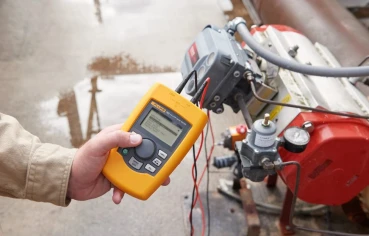
New testing process on control valves
The valves are opened and closed proportionally, and the degree of movement is varied depending on a signal varying between 4 - 20 mA applied to the input. Many valves have a feedback signal that shows the actual position as a percentage open/close value. This output can be a 4 - 20 mA signal or a digital HART variable that represents a 0 - 100 percentage of the control valve operating range.
Another important indicator of valve performance is the pressure required by the valve to move to the desired position. For example, a valve can be programmed to know if a 12 mA signal is applied it can open 50%. Smart electronics will control whether a smart pressure regulator is needed to increase or decrease the pressure when needed to move the control element to the desired position.
Providing a varying mA signal while monitoring the output milliamps or percentage of the trip signal will tell you whether a control valve is operating properly over its working range. Similarly, monitoring and recording the pressure applied to the final control elements while varying the 4 - 20 mA input signal to the valves is an important test to identify whether a valve is stuck. The relationship between pressure and mA or valve position will usually be linear if the valve is operating properly. If additional pressure is required it can often be considered for a stuck valve and will be shown if the measurement is recorded and plotted on a graph. By recording these signals, valve performance can be documented. These documented tests and results are usually called valve “characteristics”.
The valve usually includes a simple manual indicator that gives you an estimate of the percentage of movement to determine when it is operational. However, this indicator does not show you how the valve will operate under dynamic and changing conditions, and its accuracy is not guaranteed.
READ MOREAnother important indicator of valve performance is the pressure required by the valve to move to the desired position. For example, a valve can be programmed to know if a 12 mA signal is applied it can open 50%. Smart electronics will control whether a smart pressure regulator is needed to increase or decrease the pressure when needed to move the control element to the desired position.
Providing a varying mA signal while monitoring the output milliamps or percentage of the trip signal will tell you whether a control valve is operating properly over its working range. Similarly, monitoring and recording the pressure applied to the final control elements while varying the 4 - 20 mA input signal to the valves is an important test to identify whether a valve is stuck. The relationship between pressure and mA or valve position will usually be linear if the valve is operating properly. If additional pressure is required it can often be considered for a stuck valve and will be shown if the measurement is recorded and plotted on a graph. By recording these signals, valve performance can be documented. These documented tests and results are usually called valve “characteristics”.
The valve usually includes a simple manual indicator that gives you an estimate of the percentage of movement to determine when it is operational. However, this indicator does not show you how the valve will operate under dynamic and changing conditions, and its accuracy is not guaranteed.
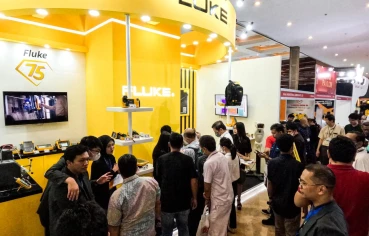
Event Con-Mine 2023
Many visitors came to Fluke's booth during the Event Construction, Infrastructure & Mining Solution (CON-MINE 2023), Thursday (1/1/2023). The exhibition, which lasted for a week at the Jakarta International Expo (JIExpo) Kemayoran Jakarta with the theme Sustainable Solutions for the Manufacturing Industry, included exhibitions on machinery, equipment, materials and services involving more than 500 exhibitors from all over Indonesia. .

The Marketing Division of PT Narmada Setia Indonesia took a group photo at the Event Construction, Infrastructure & Mining Solution (CON-MINE 2023) Jakarta International Expo (JIExpo) Kemayoran Jakarta.
READ MORE
The Marketing Division of PT Narmada Setia Indonesia took a group photo at the Event Construction, Infrastructure & Mining Solution (CON-MINE 2023) Jakarta International Expo (JIExpo) Kemayoran Jakarta.
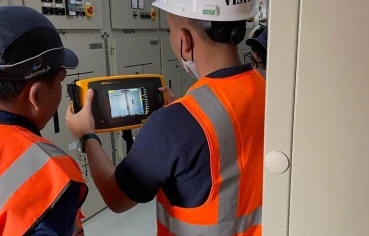
How air leak detection equipment
Fluke interviews a factory regarding an air leak. These manufacturers really help keep the wheels of the trade moving. As one of the world's leading aftermarket manufacturers of wheel service equipment, the company designs, builds and markets products with whom they are trusted and recognized.
Many of the manufacturer's processes rely on compressed air to run the approximately 400 devices in the 13,935 square meter plant—all from 200 horsepower compressors. “We use compressed air everywhere in the plant—for pneumatic tools, robot welding, laser cutting, and powder paint equipment,” says the manufacturer's president. From the compressed air comes noise and—air leakage.
Air leaks cause compressed air driven equipment to work harder, causing wasted energy. The possibility of air leaks in the plant increases with the presence of old equipment accumulated over the last decades from various plant consolidations. Listening for air leaks can be very difficult in noisy environments, so most leak detection activities are performed after business hours.
“Usually we wait until the building gets very quiet—a shift change or maintenance shutdown and we just try to listen for air leaks as much as we can,” says the maintenance supervisor. "We also use bottles of soapy water to spray any areas where there may be leaks and look for bubbles." The spray and see method requires that the maintenance team member is close enough to a possible leak to hear it and spray the solution in the correct area.
Another method for finding compressed air leaks is using an ultrasonic leak detector. This method requires highly trained personnel and a considerable amount of time is required to find all leaks. Small leaks can be hard for the human ear to hear, and not all leaks are in easily accessible areas. This can be a troublesome task.
READ MOREMany of the manufacturer's processes rely on compressed air to run the approximately 400 devices in the 13,935 square meter plant—all from 200 horsepower compressors. “We use compressed air everywhere in the plant—for pneumatic tools, robot welding, laser cutting, and powder paint equipment,” says the manufacturer's president. From the compressed air comes noise and—air leakage.
Controlling energy waste
Air leaks cause compressed air driven equipment to work harder, causing wasted energy. The possibility of air leaks in the plant increases with the presence of old equipment accumulated over the last decades from various plant consolidations. Listening for air leaks can be very difficult in noisy environments, so most leak detection activities are performed after business hours.
“Usually we wait until the building gets very quiet—a shift change or maintenance shutdown and we just try to listen for air leaks as much as we can,” says the maintenance supervisor. "We also use bottles of soapy water to spray any areas where there may be leaks and look for bubbles." The spray and see method requires that the maintenance team member is close enough to a possible leak to hear it and spray the solution in the correct area.
Another method for finding compressed air leaks is using an ultrasonic leak detector. This method requires highly trained personnel and a considerable amount of time is required to find all leaks. Small leaks can be hard for the human ear to hear, and not all leaks are in easily accessible areas. This can be a troublesome task.
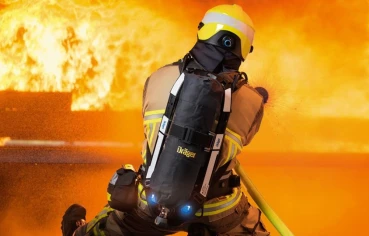
Dräger SCBA PSS® AirBoss
Saat Anda sedang menelepon, Anda tidak boleh dibatasi oleh perlindungan Anda sendiri. Dräger PSS® AirBoss yang baru menawarkan ergonomi yang unggul dan merupakan salah satu sistem alat bantu pernapasan yang paling ringan. Dengan teknologi konektivitas terbaru, Dräger bertujuan untuk meningkatkan keselamatan dan efisiensi Anda secara signifikan. Dengan keselamatan dan fleksibilitas yang maksimal, tidak ada yang dapat menghentikan Anda menyelesaikan pekerjaan.
Ergonomi unggul
Bergerak bebas seakan tidak ada apa pun di punggung Anda: Dengan penyesuaian ketinggian tiga langkah, sabuk pinggang yang dapat diputar dan digeser, Anda akan bergerak mudah dalam situasi sulit.
Sangat ringan
Mungkin SCBA pemadam kebakaran paling ringan di kelasnya karena bahannya yang ringan. Pilihan desain yang cerdas membuatnya terasa lebih ringan dari sebelumnya.
Konektivitas yang tahan masa depan
Solusi yang terhubung meningkatkan keselamatan dan efisiensi Anda: Anda mengetahui situasi Anda. Anggota tim dan pemimpin Anda juga mengetahuinya – jadi mereka mendukung Anda.
Selama lebih dari 130 tahun, kami telah memperoleh pengetahuan luas dalam bidang-bidang penting teknologi keselamatan: kegunaan, kemudahan servis, konektivitas, dan, tentu saja, keselamatan. Dräger PSS® AirBoss yang sangat ringan dengan ergonomi dan solusi konektivitas yang hebat adalah buktinya.
Kegunaan
Ergonomis, dapat disesuaikan, dan mudah ditangani – itulah yang kami inginkan dari produk kami. Dräger PSS® AirBoss yang ringan juga tidak berbeda: Dengan distribusi berat yang seimbang, produk ini menyebabkan lebih sedikit stres fisik dan kelelahan sehingga Anda selalu siap untuk panggilan berikutnya.
Konektivitas
Waspadai bahaya: Dengan mengumpulkan, menghubungkan, dan memproses semua informasi dari lokasi kejadian, Anda dan pemimpin tim selalu mengetahui bahaya yang Anda hadapi. Dengan semua fitur penghubungnya, alat bantu pernapasan ini meningkatkan kewaspadaan dan keselamatan Anda terhadap situasi.
Keamanan+
PSS® AirBoss yang baru membantu Anda untuk fokus pada tugas Anda alih-alih berkonsentrasi pada SCBA. SCBA baru kami membuatnya semudah dan seefisien mungkin untuk menjaga Anda tetap aman saat bekerja di lingkungan yang berbahaya. Itulah yang kami sebut Safety+.
Kemudahan servis
Memastikan kesiapan Anda. Selain waktu penyelesaian yang singkat, PSS® AirBoss dirancang dengan mempertimbangkan kesejahteraan petugas pemadam kebakaran dan teknisi bengkel.
Hubungi kami sekarang juga untuk mendapatkan penawaran harga SCBA dengan harga terbaik.
READ MOREErgonomi unggul
Bergerak bebas seakan tidak ada apa pun di punggung Anda: Dengan penyesuaian ketinggian tiga langkah, sabuk pinggang yang dapat diputar dan digeser, Anda akan bergerak mudah dalam situasi sulit.
Sangat ringan
Mungkin SCBA pemadam kebakaran paling ringan di kelasnya karena bahannya yang ringan. Pilihan desain yang cerdas membuatnya terasa lebih ringan dari sebelumnya.
Konektivitas yang tahan masa depan
Solusi yang terhubung meningkatkan keselamatan dan efisiensi Anda: Anda mengetahui situasi Anda. Anggota tim dan pemimpin Anda juga mengetahuinya – jadi mereka mendukung Anda.
Selama lebih dari 130 tahun, kami telah memperoleh pengetahuan luas dalam bidang-bidang penting teknologi keselamatan: kegunaan, kemudahan servis, konektivitas, dan, tentu saja, keselamatan. Dräger PSS® AirBoss yang sangat ringan dengan ergonomi dan solusi konektivitas yang hebat adalah buktinya.
Kegunaan
Ergonomis, dapat disesuaikan, dan mudah ditangani – itulah yang kami inginkan dari produk kami. Dräger PSS® AirBoss yang ringan juga tidak berbeda: Dengan distribusi berat yang seimbang, produk ini menyebabkan lebih sedikit stres fisik dan kelelahan sehingga Anda selalu siap untuk panggilan berikutnya.
Konektivitas
Waspadai bahaya: Dengan mengumpulkan, menghubungkan, dan memproses semua informasi dari lokasi kejadian, Anda dan pemimpin tim selalu mengetahui bahaya yang Anda hadapi. Dengan semua fitur penghubungnya, alat bantu pernapasan ini meningkatkan kewaspadaan dan keselamatan Anda terhadap situasi.
Keamanan+
PSS® AirBoss yang baru membantu Anda untuk fokus pada tugas Anda alih-alih berkonsentrasi pada SCBA. SCBA baru kami membuatnya semudah dan seefisien mungkin untuk menjaga Anda tetap aman saat bekerja di lingkungan yang berbahaya. Itulah yang kami sebut Safety+.
Kemudahan servis
Memastikan kesiapan Anda. Selain waktu penyelesaian yang singkat, PSS® AirBoss dirancang dengan mempertimbangkan kesejahteraan petugas pemadam kebakaran dan teknisi bengkel.
Hubungi kami sekarang juga untuk mendapatkan penawaran harga SCBA dengan harga terbaik.

Drager Portable Gas Detectors
Banyak bahaya yang tidak dapat dideteksi oleh indera manusia: gas beracun, kekurangan oksigen, gas dan uap yang mudah terbakar. Semua bahaya ini menimbulkan ancaman serius terhadap kehidupan manusia dan keselamatan pabrik di banyak cabang industri. Detektor gas portabel memberi peringatan dini kepada pekerja dan meningkatkan keselamatan kerja.
Jika menyangkut deteksi gas yang andal, Anda dapat mengandalkan detektor gas portabel dari Dräger. Kami memiliki pengalaman lebih dari 70 tahun dalam teknologi ini dan menawarkan rangkaian lengkap detektor gas yang andal , stasiun untuk kalibrasi dan pengujian benturan , serta solusi perangkat lunak , komponen sistem yang bermanfaat, dan aksesori.
Detektor multi-gas
Detektor multi-gas generasi baru ini ideal untuk perlindungan pribadi, pemantauan area, akses masuk ke ruang terbatas (CSE) serta pengukuran keamanan poros, saluran, atau tangki. Detektor multi-gas portabel ini memberikan pengukuran yang andal, sementara sensor tahan lama yang dirancang di dalam negeri menjamin keamanan maksimum yang dipadukan dengan biaya pengoperasian yang sangat rendah.
Detektor gas tunggal
Jika bahaya gas atau uap beracun dapat dipersempit menjadi satu gas atau zat utama, perangkat pengukur dan peringatan gas tunggal adalah solusi ideal untuk pemantauan pribadi di tempat kerja. Detektor gas tunggal kami berukuran kecil, kuat, dan ergonomis.
Tabung deteksi gas
Tabung Dräger memungkinkan banyak aplikasi yang mengharuskan hasil pengukuran tersedia secara instan. Terutama jika pengukuran individual atau frekuensi pengukuran rendah sudah cukup, tabung memiliki keunggulan dibandingkan peralatan elektronik. Tabung relatif murah dan sangat mudah digunakan.
Hubungi kami sekarang juga untuk mendapatkan penawaran harga Gas Detector dengan harga terbaik.
READ MOREJika menyangkut deteksi gas yang andal, Anda dapat mengandalkan detektor gas portabel dari Dräger. Kami memiliki pengalaman lebih dari 70 tahun dalam teknologi ini dan menawarkan rangkaian lengkap detektor gas yang andal , stasiun untuk kalibrasi dan pengujian benturan , serta solusi perangkat lunak , komponen sistem yang bermanfaat, dan aksesori.
Detektor multi-gas
Detektor multi-gas generasi baru ini ideal untuk perlindungan pribadi, pemantauan area, akses masuk ke ruang terbatas (CSE) serta pengukuran keamanan poros, saluran, atau tangki. Detektor multi-gas portabel ini memberikan pengukuran yang andal, sementara sensor tahan lama yang dirancang di dalam negeri menjamin keamanan maksimum yang dipadukan dengan biaya pengoperasian yang sangat rendah.
Detektor gas tunggal
Jika bahaya gas atau uap beracun dapat dipersempit menjadi satu gas atau zat utama, perangkat pengukur dan peringatan gas tunggal adalah solusi ideal untuk pemantauan pribadi di tempat kerja. Detektor gas tunggal kami berukuran kecil, kuat, dan ergonomis.
Tabung deteksi gas
Tabung Dräger memungkinkan banyak aplikasi yang mengharuskan hasil pengukuran tersedia secara instan. Terutama jika pengukuran individual atau frekuensi pengukuran rendah sudah cukup, tabung memiliki keunggulan dibandingkan peralatan elektronik. Tabung relatif murah dan sangat mudah digunakan.
Hubungi kami sekarang juga untuk mendapatkan penawaran harga Gas Detector dengan harga terbaik.
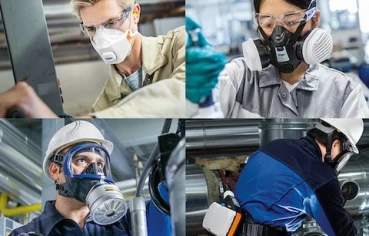
Dräger Air Purifying Respirators
Di mana pun zat berbahaya mengancam atau menghalangi pernapasan yang aman, Anda memerlukan peralatan pelindung pernapasan yang andal. Dräger menawarkan portofolio lengkap peralatan pelindung pernapasan ringan mulai dari Masker Debu, Masker Setengah, Masker Wajah Penuh, dan Respirator Pembersih Udara Bertenaga (PAPR).
Masker Debu (N95 & FFP1, FFP2 & FFP3)
Dräger menawarkan berbagai macam Masker Debu sekali pakai untuk perlindungan terhadap debu halus, partikel padat dan cair. Kelas perlindungan NIOSH N95 & EN FFP (FFP1, FFP2 & FFP3) tersedia berdasarkan model tertentu.
Masker Setengah Wajah
Baik Anda mencari masker setengah dengan satu filter atau dua filter, Dräger memiliki solusi perlindungan pernapasan yang tepat untuk Anda. Terlindungi dari partikel, gas, dan uap – bila dikombinasikan dengan filter pernapasan yang sesuai.
Masker Wajah Penuh
Digunakan oleh para profesional dalam berbagai macam aplikasi, masker wajah penuh dari Dräger menawarkan keamanan optimal dan kenyamanan luar biasa di lingkungan yang menghadirkan situasi sangat berbahaya dan berbagai macam bahan kimia berbahaya.
Respirator Pembersih Udara Bertenaga (PAPR)
Respirator Pemurni Udara Bertenaga Baterai adalah perangkat yang dioperasikan dengan baterai yang menyedot udara sekitar dan mengalirkannya melalui filter ke bagian kepala – sehingga hampir tidak ada hambatan pernapasan. Respirator ini dapat dikenakan untuk jangka waktu yang lebih lama dan memungkinkan pengguna untuk bernapas dengan bebas selama melakukan tugas yang berat. Ada berbagai filter dan bagian kepala yang dapat dipilih, untuk melengkapi sistem perlindungan pernapasan Anda.
Hubungi kami sekarang juga untuk mendapatkan penawaran Respirator Pembersih Udara (APR) dengan harga terbaik.
READ MOREMasker Debu (N95 & FFP1, FFP2 & FFP3)
Dräger menawarkan berbagai macam Masker Debu sekali pakai untuk perlindungan terhadap debu halus, partikel padat dan cair. Kelas perlindungan NIOSH N95 & EN FFP (FFP1, FFP2 & FFP3) tersedia berdasarkan model tertentu.
Masker Setengah Wajah
Baik Anda mencari masker setengah dengan satu filter atau dua filter, Dräger memiliki solusi perlindungan pernapasan yang tepat untuk Anda. Terlindungi dari partikel, gas, dan uap – bila dikombinasikan dengan filter pernapasan yang sesuai.
Masker Wajah Penuh
Digunakan oleh para profesional dalam berbagai macam aplikasi, masker wajah penuh dari Dräger menawarkan keamanan optimal dan kenyamanan luar biasa di lingkungan yang menghadirkan situasi sangat berbahaya dan berbagai macam bahan kimia berbahaya.
Respirator Pembersih Udara Bertenaga (PAPR)
Respirator Pemurni Udara Bertenaga Baterai adalah perangkat yang dioperasikan dengan baterai yang menyedot udara sekitar dan mengalirkannya melalui filter ke bagian kepala – sehingga hampir tidak ada hambatan pernapasan. Respirator ini dapat dikenakan untuk jangka waktu yang lebih lama dan memungkinkan pengguna untuk bernapas dengan bebas selama melakukan tugas yang berat. Ada berbagai filter dan bagian kepala yang dapat dipilih, untuk melengkapi sistem perlindungan pernapasan Anda.
Hubungi kami sekarang juga untuk mendapatkan penawaran Respirator Pembersih Udara (APR) dengan harga terbaik.

